New Mountain Bike Day
Welcome to the exciting world of mountain biking! Whether you are new to the sport or a seasoned veteran, we are excited that you're interested in mountain biking. We'd love to help guide you in the right direction whether you're shopping for your first cross country hardtail or it's time for that long travel bike park rig in your life. It's important to take your time, do your research, and choose the right bike for your specific riding needs and desires! Here are some key questions to ask yourself when contemplating a new bicycle purchase.
- Who do I want to ride with?
- What kind of bikes do they ride?
- What bikes in the past did I like or dislike?
- Where do I want my new bike to be able to take me?
These questions will help better determine what type of bike is best for your riding style and desired skills growth. The lines between mountain bike genres have blurred tremendously in recent years. Let's dive into the different disciplines of mountain biking and break down what makes them unique.
Shop Men's Mountain Bikes Shop Women's Mountain Bikes
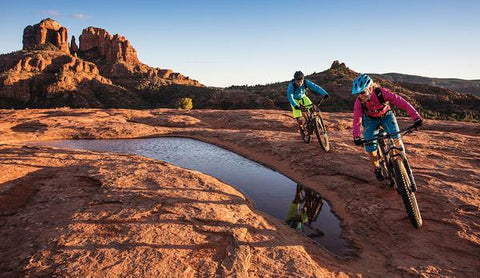
Wheel Size - 26", 27.5", 29"
What's better 29" versus 27.5" bike wheels?
When choosing the wheel size for your new mountain bike there are several aspects of riding to consider as your decision will affect how your bike performs. The three main aspects of riding affected by wheel size are overall weight, pedal efficiency, and level of control. 26" is the old standard, made obsolete by 29" and now 27.5" Each rider has their own preference and reasoning behind their feelings. Let's break down how choosing between a 27.5" or 29" wheel can affect how your bike rides.
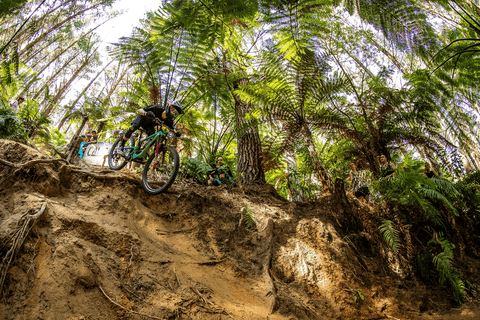
1. LIGHTER WEIGHT
Significantly lower bike and rotational wheel weight helps you climb faster with less effort.
Overall Bike Weight
Compare the weights of identically equipped bikes with different wheel sizes and you'll see substantial weight differences. As expected, the 26-inch-wheel bike is somewhat lighter than the 27.5, and substantially lighter than the 29 (up to two pounds of overall bike weight savings from 29 to 27.5). Every gram saved helps you ride faster. But there are trade offs, as we’ll discuss below.
Wheel/Tire Weight
The overall weight of a 27.5 wheel set (wheel, tire and inner tube) is only 5% greater than that of an identically built 26-inch wheel set. Compare this to the 12% increase of a 29-inch wheel set and you can see how a seemingly small increase in diameter results in substantial weight gain—and poorer performance when climbing or accelerating.
Weight Comparison
Static wheel weight
Lighter wheels/tires result in a quicker acceleration and lighter overall bike weight - a win-win combination.
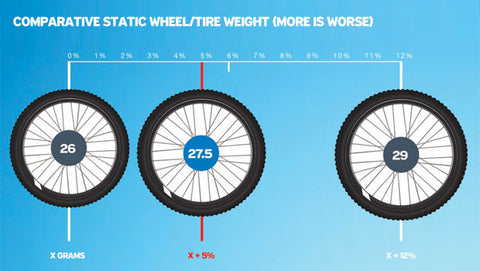
2. MORE EFFICIENT
Snappier acceleration and a reduced angle of attack for a smoother, more agile ride.
When a wheel has a larger diameter, you get a better ratio in a pedal to rotation. When you turn the crank one time with a 26” wheel, you’ll travel 26” inches. When you turn the crank on a 29” wheel--the same effort you put into the 26” wheel--you’ll travel 29”. It may not seem like much at first look, but that 3” per revolution really adds up.
Rollover
Increased wheel diameter decreases the angle of attack (the angle in which a round object intersects a square object). This is a good thing. A 29-inch wheel rolls over a 6-centimetre square-edge obstacle 14% more efficiently than a 26-inch wheel does. In comparison, a 27.5-inch wheel rolls over the same obstacle 9.8% more efficiently than a 26-inch wheel does.
Another way to analyze angle of attack is the degree of impact—where 26-inch equals X degree, 27.5 equals X-4 degrees and 29 equals X-6 degrees. Again, a shallower angle is better—so 29-inch takes the win, with 27.5 exhibiting nearly the same performance but without the weight penalty.

Acceleration
Arguably the most important benefit of 27.5 over 29 is quicker acceleration. This is the "snap" that a rider feels when they push hard on the pedals. It is affected not just by overall static weight but also where the weight is distributed throughout the wheel. The farther the weight is from the center of the hub, the slower the acceleration. So a similarly constructed 1000-gram 29-inch wheel is slower to accelerate than a 1000-gram 26-inch wheel—because the larger diameter rim and longer spokes place weight farther from the hub. The key to snappy acceleration is minimizing the weight of the outermost components (rim, nipples, spokes, tire, tube). As you can see, a 27.5-inch wheel is only 1.5% slower to accelerate than a similarly constructed 26-inch wheel, but a 29-inch wheel is 3.6% slower than a similarly constructed 26-inch wheel.

3. BETTER CONTROL
A larger tire contact patch, increased stiffness, and optimized frame geometry improve traction, braking and handling.
Traction
The larger the diameter of a wheel, the greater the contact patch of the tire. A larger contact patch results in better traction, which leads to improved acceleration, deceleration and cornering. As you can see, a 27.5-inch wheel has a similar contact patch to the 29.

Frame Stiffness
Lateral (side-to-side) frame stiffness can be affected by wheel size. To accommodate larger wheels, frame dimensions must be elongated. Therefore, a size medium 29-inch wheel frame has more lateral flex (bottom bracket and headtube) than a size medium 27.5 or 26-inch wheel frame set. Additional flex compromises handling under heavy pedaling or sharp cornering.

Frame Geometry
The larger the wheel, the more difficult it is to optimize geometry, especially on smaller frames. As the frame size decreases, headtube heights become higher (in relation to saddle height). On 26 or 27.5-inch frames, it's less of a problem, but geometry limitations can affect smaller 29-inch-wheel frames.
Types of Mountain Bikes
What type of mountain bike should i get?
Cross Country (XC) Mountain Bikes
Cross Country mountain bikes are designed for high top speed and fast acceleration with a focus on sprinting and climbing. A typical cross country bike features a front suspension fork, but no rear shock. This type of mountain bike is commonly referred to as a hardtail, as the rear of the bike is rigid and features no suspension. The user's legs and core, well, the whole body literally, receives a much higher demand from the bike as far as compensating for trail vibration and absorbing impacts. This is a great benefit to new riders as it allows the muscles, especially the twitch fibers to build memory and strength for mountain biking technique and body positioning. We recommend all riders start out on a hardtail to build the skills from the ground level. The GIANT Fathom 1 is one dialed XC bike, ready to slay singletrack and even run for the podium at your local race series.
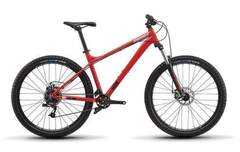
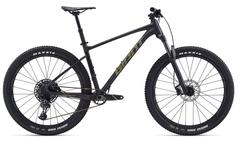
Shop Cross Country (XC) Mountain Bikes
Trail Mountain Bikes
The starting point for most mountain bike riders, trail bikes are great for everything from dirt roads to singletrack trails. They are available in a number of different configurations to better fit your riding style from hard tail to fully dialed full-suspension rigs.
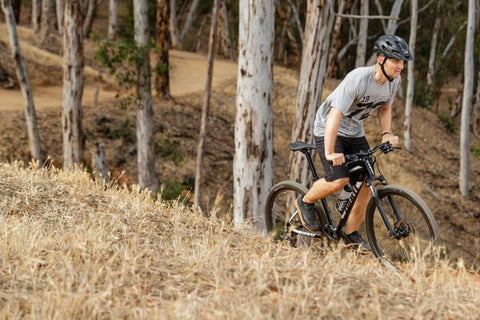
All-Mountain / Enduro Bikes
Enduro racing is the discipline of racing downhill over technical terrain, but also having to climb and push flats in order to complete the course. It combines the skills of high speed downhill navigation and stamina/endurance racing. Enduro style bikes have become popular because they are adaptable to a wide range of riding styles. This demand has given birth to the "All-Mountain" bike category as well. Not quite Enduro but much more than a Cross Country bike. It seems many bikes claim to do it all, and the term "all-mountain bike" has become popular to describe models that boast to burn descents and technical terrain while still climbing strongly and sprinting the flats. These bikes are said to be stiff and responsive, yet somehow forgiving on the body. For many riders this niche is the best of all worlds mountain biking, and these bikes do vary all across the board. GIANT Bikes' Trance is an awesome example of an “all-mountain bike.” Designed to do it all, the shorter travel keeps the bike fast and snappy, but the geometry allows the bike to tackle technical features, airs, and drops that normally would demand more travel in the suspension.

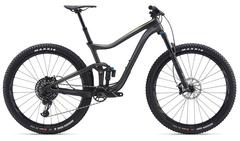
Downhill aka Freeride Mountain Bikes
The holy grail of mountain biking, the downhill segment. No matter what style mountain biking you're into, no one can resist the appreciation and allure for downhill and freeride mountain biking. These bikes are the burliest of the mountain bike spectrum, and are designed to accomplish one task; descend. A downhill-specific mountain bike is going to feature geometry, componentry, and styling all geared toward exclusively riding downhill, and fast. These bikes feature gears designed for high speed, and commonly do not have any gears suitable for climbing. In addition the brakes are larger and more efficient due to the high demand put on their stopping power in this discipline. While not every downhill bike is spec'd on the extreme end, most follow this trend and where their true riding potential is unlocked is pointed downhill. The GIANT Reign is a great example of a downhill bike, yet still has gearing for substantial climbs or sprints.
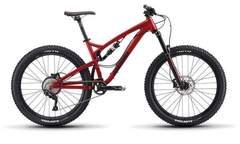
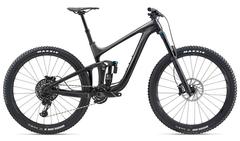
Shop Full Suspension Mountain Bikes
Electric Mountain Bikes
Take control of the trail with a electric mountain bike. Now you can climb with greater ease and comfort and ride even further. It's the perfect formula for an enjoyable day on the trail.
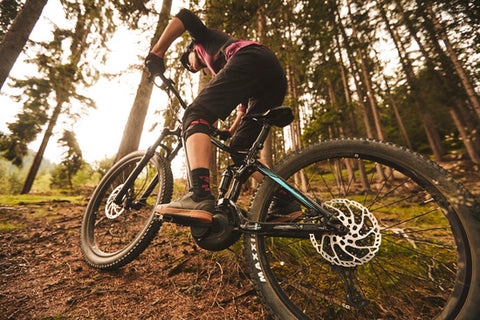 '
'
Time To Buy
When purchasing a new mountain bike you want to ensure you are getting enough bike to avoid outgrowing the bicycle as your skills improve. There's the perfect balance between your skillset and your budget, a bike exists that is ready to push your trail riding to the next level and provide more freedom, fitness and fun than you've ever known! The best way to shop for your new mountain bike is to get into your local Bicycle Warehouse today! Our expert sales team is standing by to offer advice, demo products, and talk anything cycling. Stop by today and test ride one of our GIANT mountain bikes, don't get left in the dust! We'll leave you with some tips to keep in mind when that new bike day is approaching.
- Purchase the correct size frame.
- Choose a wheel size.
- Decide on hardtail or full suspension.
- Don't focus on weight or branding.
- Ignore bells and whistles; focus on core systems. (shifting, brakes, suspension)
- Choose suspension for quality over quantity.
- Save some budget for maintenance, gear, and upgrades.
Now that you're ready to start shopping, take a look at these awesome brands. Most bikes ship direct, nearly fully assembled. We're standing by on LiveChat to help with advice, tech questions, and tailoring your new bike purchase to your exact needs.
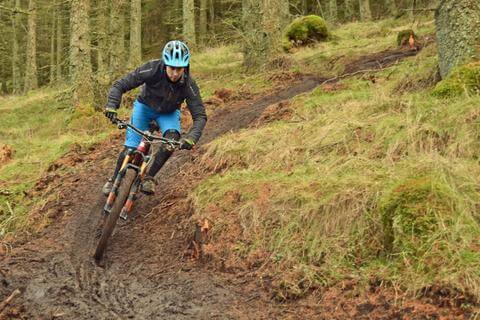
If you're local to Southern California we invite you to visit one of our Bicycle Warehouse retail stores to experience the best selection and service around.






